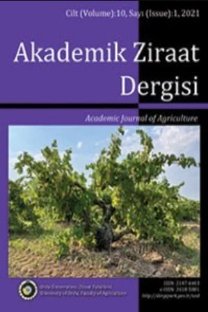Alım Noktalarına Gelen Fındık Meyvelerinde Bazı Özelliklerin Belirlenmesi: Giresun Örneği
Fındık, Corylus avellana L., Randıman, Ransimat değeri, Serbest yağ asitliği
Determination of Some Traits on Arrival of Hazelnut at Purchasing Points: The Case of Giresun
___
- AOCS. (2004). Official Methods and Recommended Practices of the American Oil Chemist’s Society, 5th ed. American Oil Chemist Society, US.
- Cui, N., Zhao, T., Han, Z., Yang Z., Wang, G., Ma, Q., & Liang, L. (2022). Characterisation of oil oxidation, fatty acid, carotenoid, squalene and tocopherol components of hazelnut oils obtained from three varieties undergoing oxidation. International Journal of Food Science & Technology, 57, 3456-3466. https://doi.org/10.1111/ijfs.15669
- Erdogan, V., & Mehlenbacher, S.A. (2000). Interspecific hybridization in hazelnut (Corylus). Journal of the American Society for Horticultural Science, 125, 489–497. doi: 10.21273/JASHS.125.4.489
- Fiskobirlik. (2004). Fındık Alım-Ekspertiz ve Saklama Yönetmeliği. Fiskobirlik Basımevi, Giresun.
- İslam, A. (2000). Ordu ilinde yetişen Türk fındık çeşitlerinde klon seleksiyonu, Doktora Tezi. Çukurova Üniversitesi, Fen Bilimleri Enstitüsü, Adana, Türkiye.
- İslam, A. (2019). Fındık ıslahında gelişmeler. Akademik Ziraat Dergisi, 8, 167-174.
- Köksal, A.İ. (2018). Türk Fındık Çeşit Kataloğu. Fındık Tanıtım Grubu, Ankara.
- TMO. (2020). Fındık satın alma şartları. Erişim adresi chromeextension://efaidnbmnnnibpcajpcglclefindmkaj/https://samsun.tarimorman.gov.tr/Belgeler/2020/EK-1_2020_yili_findik_alim_esaslari.pdf (Erişim tarihi: 17.07.2020).
- TMO. (2022). Fındık satın alma şartları. Erişim adresi https://www.tmo.gov.tr/Upload/Document/ findik/ satinalmasartlari2022.pdf (Erişim tarihi: 21.02.2023).
- Squara, S., Stilo, F., Cialiè Rosso, M., Liberto, E., Spigolon, N., Genova, G., & Cordero, C. (2022). Corylus avellana L. aroma blueprint: Potent odorants signatures in the volatilome of high quality hazelnuts. Frontiers in Plant Science, 13, 840028. doi: 10.3389/fpls.2022.840028
- Turan, A. (2007). Giresun ili Bulancak ilçesi Tombul fındık klon seleksiyonu. Yüksek Lisans Tezi, Ondokuz Mayıs Üniversitesi, Fen Bilimleri Enstitüsü, Samsun.
- Turan, A., & Beyhan, N. (2009). Investigation of the pomological characteristics of selected Tombul hazelnut clones in the Bulancak area of Giresun province. Seventh International Congress on Hazelnut, Book of Proceeding (61–66), 23–27 June, Viterbo, Italy.
- Turan, A. (2017). Fındıkta kurutma yöntemlerinin meyve kalitesi ve muhafazası üzerine etkileri. Doktora Tezi, Ordu Üniversitesi, Fen Bilimleri Enstitüsü, Ordu.
- Turan, A. (2018a). Effect of drying methods on fatty acid profile and oil oxidation of hazelnut oil during storage. European Food Research and Technology, 244(12), 2181–2190. https://doi.org/10.1007/s00217-018-3128–y
- Turan, A. (2018b). Effect of drying methods on nut quality of hazelnuts (Corylus avellana L.). Journal of Food Science and Technology, 55(11), 4554–4565.https://doi.org/10.1007/s13197–018–3391–8
- Turan, A. (2019a). Kurutma yöntemlerinin fındığın fiziksel özellikleri üzerine etkisi. Anadolu Tarım Bilimleri Dergisi, 34 (3), 296-303. DOI: 10.7161/omuanajas.536346
- Turan, A. (2019b). Effect of drying on the chemical composition of Çakıldak (cv) hazelnuts during storage. Grasas y Aceites, 70(1), e296.
- Turan, A., & İslam, A. (2019). Tombul fındık çeşidinde yağ oksidasyonunu azaltacak kurutma yönteminin belirlenmesi. Gıda, 44(4), 563-575.
- Turan, A. (2021). Effect of the damages caused by the green shield bug (Palomena prasina L.) on the qualitative traits of hazelnuts. Grasas Aceites, 72 (1), e391.
- Turan, A. (2022). Clonal selection of ‘Mincane’ hazelnut cv: Physical properties. Karadeniz Fen Bilimleri Dergisi, 12 (2), 1081-1097. https://doi.org/10.31466/kfb d1181029
- Velasco, J., Andersen, M.L., & Skibsted, L.H. (2004). Evaluation of oxidative stability of vejetable oils by monitoring the tendency to tadcal formation. A comparison of electron spin resonance spectroscopy with the rancimant method and differential scanning calorimetry scanning calorimetry. Food Chemistry, 85, 623-632.
- Yao, Q., & Mehlenbacher, S.A. (2000). Heritability, variance components and correlation of morphological and phenological traits in hazelnut. Plant Breeding, 119, 369-381.
- ISSN: 2147-6403
- Yayın Aralığı: Yılda 2 Sayı
- Başlangıç: 2012
- Yayıncı: Ordu Üniversitesi Ziraat Fakültesi
Ceylan GEVREK, Uğur YİĞİT, Muharrem TÜRKKAN
‘Kalınkara’ Fındık Çeşidinde Çotanak Dökümü
‘Çetiner’ Fındık (Corylus avellana L.) Çeşidinin Fenolojik, Pomolojik ve Morfolojik Özellikleri
Fındık Küllemesi Hastalığının Kimyasal Mücadelesine Alternatif Uygulamalar
Arzu COŞKUNTUNA, Şehriban ÇELİK TUĞLU
Fındıkta kültürel uygulamalar: Giresun örneği
Ali TURAN, Mehmet AKGÜN, Emre KAN
Ordu-Kumru Yöresi Fındık Bahçelerinin Toprak Verimlilik Durumlarının Belirlenmesi
Mehmet Fikret BALTA, Bilal SAYAR, Orhan KARAKAYA, Tuncay KAYA, Hüseyın KIRKAYA
Kalınkara Fındık Çeşidinde İç Meyve İriliğinin Biyoaktif Bileşikler Üzerine Etkisi
Fındık Meyvesi ile Yaprakların Mineral Bileşimleri Arasındaki İlişkiler
Xenon Test Cihazıyla Işığa Maruz Bırakılan β-Karoten Takviyeli Fındık Yağının Oksidasyon Kararlılığı
